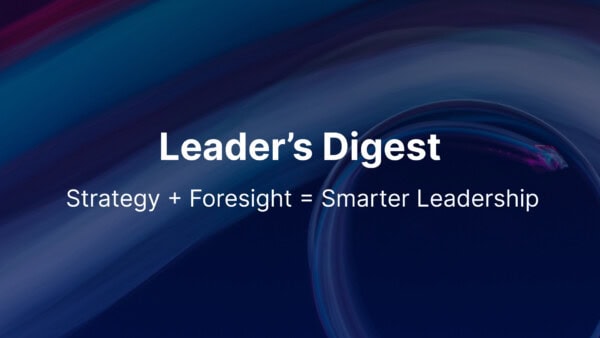10Feb2025
Foresight informs strategy by identifying risks and opportunities, ensuring that operations are aligned with future developments. However, foresight isn’t an established function in many of today’s organizations, as our friends at Futures Platform pointed out. Relying on their expertise, we have created a guide for leaders to begin integrating strategic foresight into their businesses.
“Strategic foresight has the greatest impact when it’s a continuous process rather than a one-time exercise. The key is to integrate it into existing organizational processes so it directly informs decision-making. To be effective, foresight results should also be communicated in a way that resonates with stakeholders—when they address real needs, they become an integral part of strategic discussions rather than an isolated exercise.”
Juha Mattsson, CEO at Futures Platform
Starting small is wise, and the interest of even one person in an organization can be enough to begin. In this blog, we’re setting you on the path of strategic foresight in two parts:
- How to Get Started with Strategic Foresight: The implementation of strategic foresight explained in three stages.
- Useful Methods and Approaches: Briefly introducing four tools to help you get started: Horizon scanning, futures mornings, futures wheel, and 2×2 scenario planning.
How to Get Started with Strategic Foresight
In the beginning, foresight efforts are often limited to specific projects, such as addressing immediate challenges. As foresight matures, efforts become more structured and consistent and can be used to inform decision-making across the organization.
Stage 1: Getting Everyone on Board
Foresight is inherently a collaborative discipline that thrives on diverse perspectives. Introducing foresight often involves overcoming internal resistance, which is eased by encouraging participation, knowledge-sharing, and co-creation across different teams and departments. Ultimately, involving both internal and external stakeholders ensures that foresight efforts remain aligned with organizational needs and real-world challenges.
“Collaboration is at the heart of strategic foresight. Engaging colleagues from different departments brings in diverse perspectives and embeds futures-thinking across the organization. When foresight is shared across teams, it becomes a core part of the organizational culture and decision-making.”
Juha Mattsson, CEO at Futures Platform
Identify Advocates
Identify advocates in your organization who understand the importance of foresight and can help promote its value to key decision-makers. Encourage employees to contribute ideas and insights and create opportunities to engage in foresight projects. You can also collaborate with the advocates to identify how foresight benefits your organization in practice.
Build a Foresight Team
A dedicated team is essential for implementing and sustaining your foresight efforts, but building this team often happens incrementally. Start with the resources and talent available, and expand as foresight becomes more embedded in your organization.
- Focus on assembling a small, committed team of 1-3 people who are enthusiastic and skilled in futures thinking, trend analysis, or research.
- Define their roles and responsibilities clearly and assign specific tasks such as horizon scanning and scenario planning.
- Establish regular check-ins to monitor progress and adjust responsibilities as the team grows.
- Collaborate with employees from other departments to fill skill or resource gaps and foster a network of “foresight contributors” across the organization who can provide insights or expertise as needed.
Collaborate with Stakeholders
Collaboration across departments and with external partners expands the foresight team’s capacity and ensures buy-in across the organization. Stakeholders bring valuable perspectives and expertise that enrich foresight work and help translate findings into action points. Collaboration also fosters trust and ensures that foresight remains relevant and impactful.
- Identify internal stakeholders and external partners to engage in foresight activities.
- Actively involve stakeholders in analyzing alternative futures and developing foresight deliverables through workshops, brainstorming sessions, and other collaborative activities.
- Integrate foresight into existing organizational functions, for example, strategy, innovation, risk management, and R&D, ensuring that stakeholders see it as a valuable, actionable tool for decision-making.
Stage 2: Establishing the Process
Foresight requires a systematic approach to gather insights, analyze them with different methods and tools, and integrate findings into decision-making. Starting small, the process is upheld by your foresight team. As foresight becomes more rooted and widespread in your organization, the different foresight functions can become more spread out, but the process remains.
Define Objectives and Deliverables
You should define clear workflows, schedules, deliverables, and responsibilities for foresight activities.
- Identify
- short-term goals (e.g., identifying quick wins or addressing immediate challenges)
- long-term goals (e.g., integrating foresight into annual strategic planning, identifying emerging market opportunities, building resilience against potential disruptions, or guiding long-term investments).
- Establish processes for continuously gathering insights and conducting collaborative analysis to help meet your goals.
- Specify the type of foresight deliverables, such as reports or scenarios, you will produce.
Invest in Resources and Tools
Early foresight efforts may rely on small teams, but scaling up requires broader investment in resources and systems. Digital tools for horizon scanning, collaborative analysis, and data visualization are essential to make foresight work structured and efficient. Resources must be allocated to support both the adaptation and evaluation of relevant tools.
“Foresight isn’t a one-size-fits-all process. The most important step is to start—experiment with different methods and refine your approach as you go. Over time, you’ll find what works best for your organization’s strategic needs and decision-making culture.”
Shiori Ota, Foresight Analysis Manager at Futures Platform
Learn by Doing
Foresight activities can look different for every organization and getting started doesn’t require perfection. Experimentation helps you discover what approach can work best in your context—small wins build confidence and showcase foresight’s potential.
- Launch small, manageable foresight experiments.
- Identify quick wins that demonstrate foresight’s practical benefits.
- Use lessons from initial experiments to refine your approach.
Stage 3: Continuous Communication
After establishing the process of cultivating foresight knowledge and turning it into actionable deliverables, you need to communicate the information with relevant stakeholders. Identify the foresight needs across your organization and communicate insights based on what is most beneficial to each stakeholder.
Share Knowledge and Skills
Embedding futures thinking across teams ensures that foresight is not limited to a single group but becomes an organizational mindset. Organizing cross-team workshops can help spread foresight skills and knowledge, which in turn helps integrate foresight into existing organizational functions.
- Organize internal training workshops on foresight methods and tools.
- Provide lightweight introductions to key foresight concepts, such as trends, weak signals, wild cards, horizon scanning, scenario planning, etc.
- Customize training sessions to address the specific needs of your teams.
- Provide training on foresight tools to team members and stakeholders.
Develop a Communication Strategy
Develop a communication strategy for sharing foresight findings that are actionable, relevant, and timely to support different stakeholders in their decision-making. Share foresight findings and updates regularly with stakeholders through reports, presentations, or dedicated sessions and ask for feedback.
“Foresight can feel overwhelming at first, but you don’t need to master every method to make an impact. Start with horizon scanning—systematically tracking trends, weak signals of change, and potential disruptions in your industry and beyond. This simple habit builds a strong foundation for deeper foresight work and gives you the advantage of spotting change signals early on – so you can act before the market does.”
Max Stucki, Senior Manager, Foresight Process at Futures Platform
Useful Methods and Approaches
Horizon Scanning
Horizon scanning is a continuous process of monitoring signals of change in the external environment. It helps organizations anticipate trends, risks, and opportunities for strategic planning, innovation, and risk management.
- Define Your Topic: Identify a focus area and craft 1-3 research questions. List critical issues, identify common themes, and frame core questions with a specific time frame.
- Search for Trends and Signals: Expand perspectives by identifying early signals of change. Use tools like PESTE analysis, industry reports, news media, expert insights, social media discussions, and trend-tracking tools.
- Assess and Prioritize Findings: Evaluate identified trends collaboratively. Use voting or ranking methods to determine the most significant signals. Typically, 10-20% of low-impact phenomena are discarded, allowing focus on high-priority trends.
- Analyze and Answer the Research Question: Examine shortlisted trends through the lens of the research question. Assess their implications for business, industry, or policy and rank based on factors like timing, impact, and relevance.
- Formulate Action Steps: Use findings to develop strategic responses, whether scenario planning, innovation strategies, or risk mitigation.
Futures Mornings
Futures Mornings are interactive sessions designed to introduce foresight thinking in organizations through theory and practical exercises. Using it can help you link day-to-day operations with strategic actions.
- Select a Topic: Choose a relevant theme for your sessions, aligning it with your organization’s focus areas. Structured topics, such as industry-specific trends, ensure meaningful discussions and strategic insights.
- Plan Structure and Scope: Organize a series of three 60–75-minute sessions. Allocate time for introducing foresight principles and explaining the reason for the sessions.
- Design Interactive Exercises: Facilitate discussions on emerging trends and their future impacts. Use exercises like imagining preferred futures, scenario mapping, or challenging assumptions to engage participants.
- Keep Up the Momentum: Iterate insights across sessions. Have participants prioritize trends, identify gaps, and refine their future perspectives over time: Examine, Discuss, Update, and Re-examine.
Futures Wheel
The Futures Wheel is a simple yet powerful visual tool that helps map out the potential direct and indirect consequences of a trend, event, or decision. By using it, you can uncover ripple effects and explore how change might unfold over time, without needing deep expertise in foresight methodologies.
- Select a Change or Event: Choose a trend, innovation, policy shift, or disruption that you want to explore. For example; “The rise of AI-driven automation in the workplace.”
- Brainstorm Primary Impacts: Identify the first-level, immediate consequences of this change.
- Explore Secondary Impacts: For each primary impact, think about the next-level consequences that follow it.
- Continue Expanding the Wheel: Keep adding layers until you have a broad view of potential outcomes—both positive and negative. This helps identify hidden risks and emerging opportunities that might not be obvious at first.
2×2 Scenario Planning
2×2 Scenario Planning helps organizations explore future possibilities by creating four distinct scenarios based on two critical uncertainties. It’s simple, flexible, and ideal for strategic planning, allowing teams to analyze potential outcomes and prepare for different futures.
- Define Two Axes: Identify the two most impactful and uncertain drivers that could shape your future. These will form the X and Y axes of your scenario matrix. They should significantly influence your organization’s strategy, operations, or business model.
- Describe the Ends of the Drivers: Draw a matrix with each axis representing one key driver. Define the two extremes for each to create four possible futures.
- Define the Perspective: Clarify the specific context your scenarios will explore. You can take a broad approach or focus on specific areas like consumer behavior, market conditions, or geopolitical factors.
- Write the Scenario Narratives: Describe each quadrant’s possible future based on its unique combination of uncertainties. Guide discussion with key questions, such as market reactions or regulatory shifts. Finally, assign a title to each scenario for easy reference.

 by:
by: 

